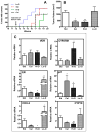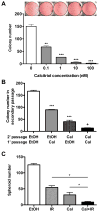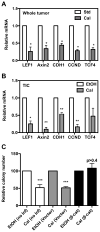Inhibition of Mouse Breast Tumor-Initiating Cells by Calcitriol and Dietary Vitamin D
- PMID: 25934710
- PMCID: PMC4549392
- DOI: 10.1158/1535-7163.MCT-15-0066
Inhibition of Mouse Breast Tumor-Initiating Cells by Calcitriol and Dietary Vitamin D
Abstract
The anticancer actions of vitamin D and its hormonally active form, calcitriol, have been extensively documented in clinical and preclinical studies. However, the mechanisms underlying these actions have not been completely elucidated. Here, we examined the effect of dietary vitamin D and calcitriol on mouse breast tumor-initiating cells (TICs, also known as cancer stem cells). We focused on MMTV-Wnt1 mammary tumors, for which markers for isolating TICs have previously been validated. We confirmed that these tumors expressed functional vitamin D receptors and estrogen receptors (ER) and exhibited calcitriol-induced molecular responses including ER downregulation. Following orthotopic implantation of MMTV-Wnt1 mammary tumor cells into mice, calcitriol injections or a vitamin D-supplemented diet caused a striking delay in tumor appearance and growth, whereas a vitamin D-deficient diet accelerated tumor appearance and growth. Calcitriol inhibited TIC tumor spheroid formation in a dose-dependent manner in primary cultures and inhibited TIC self-renewal in secondary passages. A combination of calcitriol and ionizing radiation inhibited spheroid formation more than either treatment alone. Further, calcitriol significantly decreased TIC frequency as evaluated by in vivo limiting dilution analyses. Calcitriol inhibition of TIC spheroid formation could be overcome by the overexpression of β-catenin, suggesting that the inhibition of Wnt/β-catenin pathway is an important mechanism mediating the TIC inhibitory activity of calcitriol in this tumor model. Our findings indicate that vitamin D compounds target breast TICs reducing tumor-initiating activity. Our data also suggest that combining vitamin D compounds with standard therapies may enhance anticancer activity and improve therapeutic outcomes.
©2015 American Association for Cancer Research.
Conflict of interest statement
Figures






Similar articles
-
Vitamin D mitigates the adverse effects of obesity on breast cancer in mice.Endocr Relat Cancer. 2016 Apr;23(4):251-64. doi: 10.1530/ERC-15-0557. Epub 2016 Jan 27. Endocr Relat Cancer. 2016. PMID: 26817629 Free PMC article.
-
Dietary vitamin D₃ and 1,25-dihydroxyvitamin D₃ (calcitriol) exhibit equivalent anticancer activity in mouse xenograft models of breast and prostate cancer.Endocrinology. 2012 Jun;153(6):2576-87. doi: 10.1210/en.2011-1600. Epub 2012 Mar 27. Endocrinology. 2012. PMID: 22454149 Free PMC article.
-
The potential therapeutic benefits of vitamin D in the treatment of estrogen receptor positive breast cancer.Steroids. 2012 Sep;77(11):1107-12. doi: 10.1016/j.steroids.2012.06.005. Epub 2012 Jul 16. Steroids. 2012. PMID: 22801352 Free PMC article. Review.
-
Equivalent anticancer activities of dietary vitamin D and calcitriol in an animal model of breast cancer: importance of mammary CYP27B1 for treatment and prevention.J Steroid Biochem Mol Biol. 2013 Jul;136:289-95. doi: 10.1016/j.jsbmb.2012.08.005. Epub 2012 Aug 23. J Steroid Biochem Mol Biol. 2013. PMID: 22939886 Free PMC article. Review.
-
Efficacy of Vitamin D compounds to modulate estrogen receptor negative breast cancer growth and invasion.J Steroid Biochem Mol Biol. 2003 Feb;84(2-3):181-92. doi: 10.1016/s0960-0760(03)00028-1. J Steroid Biochem Mol Biol. 2003. PMID: 12711002
Cited by
-
Vitamin D, Th17 Lymphocytes, and Breast Cancer.Cancers (Basel). 2022 Jul 27;14(15):3649. doi: 10.3390/cancers14153649. Cancers (Basel). 2022. PMID: 35954312 Free PMC article. Review.
-
Serum Vitamin D and Risk of Breast Cancer within Five Years.Environ Health Perspect. 2017 Jul 6;125(7):077004. doi: 10.1289/EHP943. Environ Health Perspect. 2017. PMID: 28728134 Free PMC article.
-
Vitamin D3 Metabolites Demonstrate Prognostic Value in EGFR-Mutant Lung Adenocarcinoma and Can be Deployed to Oppose Acquired Therapeutic Resistance.Cancers (Basel). 2020 Mar 13;12(3):675. doi: 10.3390/cancers12030675. Cancers (Basel). 2020. PMID: 32183160 Free PMC article.
-
Calcitriol promotes M2 polarization of tumor-associated macrophages in 4T1 mouse mammary gland cancer via the induction of proinflammatory cytokines.Sci Rep. 2024 Feb 15;14(1):3778. doi: 10.1038/s41598-024-54433-x. Sci Rep. 2024. PMID: 38355711 Free PMC article.
-
Vitamin D and androgen receptor-targeted therapy for triple-negative breast cancer.Breast Cancer Res Treat. 2016 May;157(1):77-90. doi: 10.1007/s10549-016-3807-y. Epub 2016 Apr 27. Breast Cancer Res Treat. 2016. PMID: 27120467 Free PMC article.
References
-
- Angeloni V, Tiberio P, Appierto V, Daidone MG. Implications of stemness-related signaling pathways in breast cancer response to therapy. Seminars in cancer biology. 2014 - PubMed
-
- Li X, Lewis MT, Huang J, Gutierrez C, Osborne CK, Wu MF, et al. Intrinsic resistance of tumorigenic breast cancer cells to chemotherapy. Journal of the National Cancer Institute. 2008;100:672–9. - PubMed
-
- Haussler MR, Whitfield GK, Kaneko I, Haussler CA, Hsieh D, Hsieh JC, et al. Molecular mechanisms of vitamin D action. Calcified tissue international. 2013;92:77–98. - PubMed

